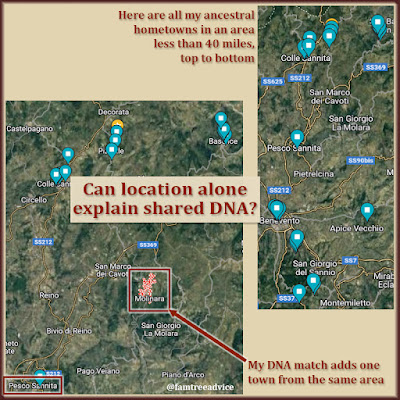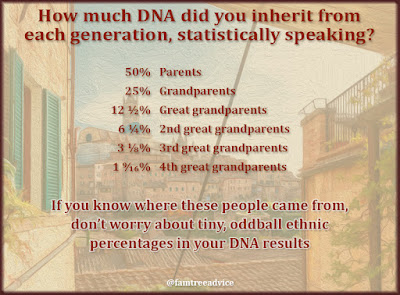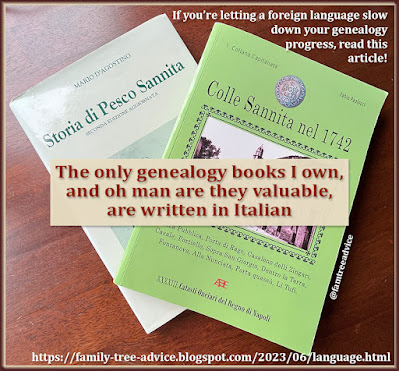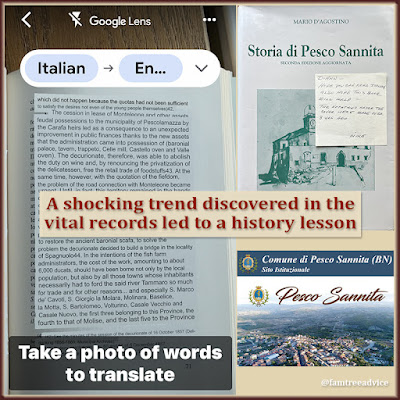On Saturday morning I mentioned to my husband that my family tree had reached exactly 60,500 people. That afternoon I had 60,854. In May I had a mere 57,238 people. "What changed?" my husband asked.
It's just my usual project. I'm piecing together every family from my Grandpa Leone's hometown of Baselice. That town in southern Italy is where I began this journey more than 15 years ago. Back then, I ordered microfilmed vital records through the Family History Center. I soon realized I needed to document everyone, and fit all the families together. Otherwise, how would I know each Leone and Iammucci's relationship to me?
The available microfilmed records at the time ended with 1860. Now the rest of the records are online on the Italian Antenati website. I have access to the 1861–1915 birth records (with a few years missing) and the 1931–1942 marriage and death records.
I've had all the 1809–1860 people and facts in my family tree for years. But I haven't yet scoured the newer documents for relationships. That's what I'm doing now. And I've only gotten through 1861–1866 so far. (Note: Many of my recent tree additions come from another town that I'm harvesting at the same time.)
 |
| Immerse yourself in your ancestor's hometown vital records to unlock all the details they hold. |
How to Identify Every Family in Town
When I began, I knew my grandfather's parents' names, and that's it! I found my great grandfather's birth record to learn his parents' names. Then I searched the surrounding years' birth records for any siblings. I did the same for my great grandmother's family.
I kept going back in time, finding the parents' marriage records to learn their parents' names, and looking for siblings. Then I came forward in time, seeing who all the siblings married and finding their children. Next, I built out the families of everyone who married into my bloodline. It was clear that 99% of the people in town had a relationship through blood or marriage. Those who didn't usually came from another town.
My method with the 1860s birth records is this:
- I check each birth record in a given year one at a time to see if:
- I have the child in my family tree already, or
- I have the parents.
- After adding the baby to my tree, I find every other baby born to the same couple throughout the years and add them. (I use a Windows program called Everything to instantly search all the records on my computer.)
- If a birth record mentions a marriage date and spouse, I add the spouse, look for the couple's children, and find the spouse's parents and siblings.
- When I've exhausted all paths, or my head is swimming and I've lost my place, I go on to the next birth record in the given year.
As I move on to the next year, I'll find that I've recently added many of the children because of the process above. (Of course I'm tracking all my finds in a spreadsheet.)
 |
| You can build out an entire family easily once you have all the basic facts. |
I can do all that pretty easily because of the preparation I did in the past. I downloaded all the document images for the town to my computer. (Today you have to download document images one at a time. Here's how.) Then I reviewed each one and renamed it. For a birth or death record, I include the name of the father. That way, I can search my computer for every Iammucci born to Antonio, for example.
Renaming the files is a great way to get familiar with all the names in a town. That helps you overcome bad handwriting.
If I hadn't downloaded and renamed all the document images, I wouldn't be able to move back and forth in time so easily. And that's how it was when I was viewing microfilm in a Family History Center. What I did then was add the main facts from each document to a text file. For each birth, I recorded:
- the baby's name, birth and baptism dates
- parents' names, ages, and occupations
- any other family names or addresses mentioned.
When I got home from the Family History Center, I began entering everything into Family Tree Maker to show all the connections. That's when I saw how the whole town was related.
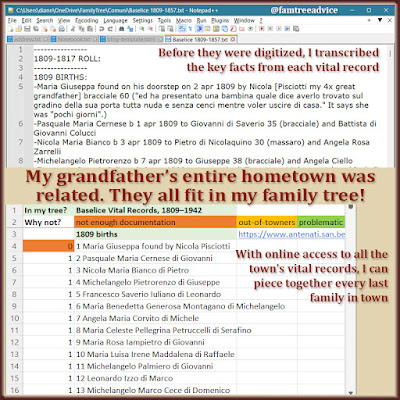 |
| Can't download all the records? You can still document your entire ancestral hometown by taking simple notes about each document you view. |
How to Get Around Missing Document Years
Since there are no available marriage records for my town from 1861–1930, things can get a bit tougher. How can I be sure who is a baby's father when so many people in town have the same name?
But I know the ins and outs of the available documents. I know, for instance, that from 1866–1873, birth records often have the name of the baby's two grandfathers. That helps me identify the right mother and father. And I know that the death records from 1931–1942 tend to be very accurate with the decedent's age. I can't say that for most records.
That means if I can't be sure which of many Maria Cece's had this baby in 1865, I have to first look for all her other babies. Finding a record that includes Maria's father's name can set her apart from the others. And if I'm lucky enough to find a death record for someone I wasn't quite sure of, the names of their parents and spouse can seal the deal.
Last week I did some research for a woman with ancestors from northern Italy. World War I must have destroyed a ton of records up north. These towns are challenging, with huge chunks of years missing from the documentation.
But I managed to push the family lines back another generation. How? I searched death records to find all the relatives' whose birth and marriage records were destroyed. How thrilling it was to find the death record of the eldest-known relative with the family name. Now I had his parents' names. I got very lucky when I found his 1811 birth record as confirmation of the names. And learned the name of his grandfather, taking the tree back to about 1746.
Get familiar with your town's records and exhaust all possibilities. Then there's no limit to how far you can expand your family tree.
And speaking of vital records:
